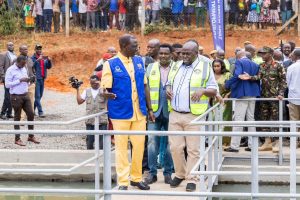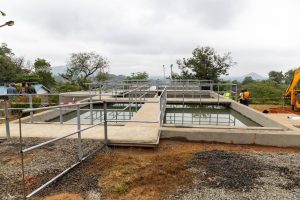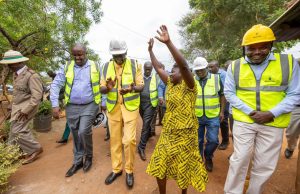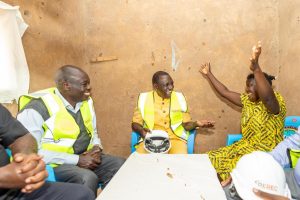Looking information about William Ruto And Rigathi Gachagua Launch Ksh500m Water Project In Marimanti Tharaka Nithi County For 30000 People ? Well, In a significant development for Tharaka Nithi County, President William Ruto and Deputy President Rigathi Gachagua have inaugurated the KSh500 million Kibung’a Kakimiki Water Project.
This new initiative aims to provide clean and reliable water to over 30,000 residents in Marimanti, a crucial area in Tharaka Nithi.
The project represents a substantial investment in local infrastructure, reflecting the government’s commitment to improving living conditions and supporting community growth. This article explores the project’s impact, key details, and future implications for the region.
William Ruto And Rigathi Gachagua Launch Ksh500m Water Project In Marimanti Tharaka Nithi County For 30000 People
- Kibung’a Kakimiki Water Project Overview
The Kibung’a Kakimiki Water Project, officially launched on [specific date], is a transformative development for Marimanti.

The project involves constructing and upgrading water supply infrastructure to ensure a consistent and clean water source for the local population. This section delves into the specifics of the project, including its scale, components, and the anticipated benefits for the community.
Objectives
The primary objectives of the Kibung’a Kakimiki Water Project are:
- To provide clean and safe drinking water to over 30,000 people in Marimanti.
- To improve the overall health and sanitation conditions in the region.
- To support agricultural activities by providing a reliable water source.
- To promote economic development by enhancing local water infrastructure.
2. Importance of the Kibung’a Kakimiki Water Project
Access to clean water is a fundamental necessity, and the Kibung’a Kakimiki project addresses a critical need in Tharaka Nithi County.
This section discusses the current water challenges faced by Marimanti residents and how the new project will alleviate these issues. It also explores the broader impact on public health, education, and economic development in the region.
Project Details Kibung’a Kakimiki Water Project
The KSh500 million investment in the water project will cover various aspects, including:
- Construction of Water Infrastructure: Building new water supply systems, including pipelines, storage tanks, and distribution networks.
- Water Treatment Facilities: Installing treatment plants to ensure the water meets health and safety standards.
- Community Engagement: Involving local residents in the project’s planning and implementation phases to ensure it meets their needs.
- Maintenance and Sustainability: Establishing mechanisms for the ongoing maintenance and management of the water infrastructure.
3. Key Figures and Stakeholders Of Kibung’a Kakimiki Water Project
The successful execution of the Kibung’a Kakimiki Water Project is attributed to the collaborative efforts of several key figures and stakeholders.
The successful execution of the Kibung’a Kakimiki Water Project is a testament to the collaborative efforts of various key figures and stakeholders who have played crucial roles in its planning and implementation. This section highlights the significant contributions of these individuals and groups.
1. President William Ruto
As the President of Kenya, William Ruto has been a driving force behind the Kibung’a Kakimiki Water Project. His leadership and commitment to addressing the water scarcity issues in Kenya’s rural areas have been instrumental in bringing this project to fruition. President Ruto’s support underscores his administration’s focus on improving infrastructure and enhancing the quality of life for all Kenyans. His involvement in the project not only reflects his dedication to national development but also his personal investment in solving pressing local challenges.
2. Deputy President Rigathi Gachagua
Deputy President Rigathi Gachagua has played a pivotal role in the project’s execution. His active participation in the launch event and his advocacy for rural development have been crucial in garnering support and mobilizing resources for the water project. Rigathi Gachagua’s presence and involvement highlight the government’s unified approach to tackling infrastructure deficits and his commitment to improving the lives of Kenyans, particularly in underserved areas like Tharaka Nithi County.
3. Governor Muthomi Njuki
Tharaka Nithi Governor Muthomi Njuki has been a key local leader in the Kibung’a Kakimiki Water Project. As the governor, Njuki has been responsible for coordinating with local authorities and ensuring that the project meets the specific needs of the Marimanti community. His role has been essential in aligning the project with local development priorities and facilitating community engagement. Governor Njuki’s leadership has helped ensure that the project is tailored to address the unique challenges faced by the region.
4. Local MPs and MCAs
The support of local Members of Parliament (MPs) and Members of County Assemblies (MCAs) has been invaluable in the successful implementation of the water project. These elected officials have advocated for the project within their constituencies, worked to secure additional resources, and facilitated communication between the government and the local population. Their involvement demonstrates the importance of local representation and collaboration in addressing community needs and ensuring the project’s success.
5. Community Leaders
Community leaders in Marimanti have played a vital role in the project’s development and implementation. Their insights and understanding of local needs have been crucial in shaping the project’s objectives and ensuring that it aligns with the community’s requirements. By actively participating in consultations and project planning, these leaders have helped build trust and fostered a sense of ownership among the residents, which is essential for the long-term sustainability of the water project.
4. Community Reactions and Expectations Of Kibung’a Kakimiki Water Project
The introduction of the Kibung’a Kakimiki Water Project has generated considerable excitement and optimism among the residents of Marimanti. This section captures community reactions, including testimonials from local residents, their expectations for the project’s outcomes, and how they anticipate the new water infrastructure will improve their daily lives.
Community Reactions and Expectations
The introduction of the Kibung’a Kakimiki Water Project has sparked considerable excitement and optimism among the residents of Marimanti, Tharaka Nithi County.
The promise of improved water access has been met with enthusiastic support from the local community, who eagerly anticipate the transformative effects of the new infrastructure on their daily lives.
Testimonials from Local Residents
Local residents have expressed their gratitude and hope for the positive impact of the water project. Many have shared personal stories highlighting the challenges they have faced due to inadequate water supply.
For instance, Mary Wambui, a resident of Marimanti, commented, “For years, we have struggled with long queues and unreliable water sources. This new project gives us hope for a more stable and consistent water supply, which will greatly improve our quality of life.”
Similarly, John Karanja, a local farmer, noted, “Reliable access to water will not only benefit my family but will also support my farming activities. With consistent water supply, I can grow more crops and provide better for my family. This project is a game-changer for us.”
Community Expectations
The expectations for the Kibung’a Kakimiki Water Project are high, with residents anticipating significant improvements in various aspects of their lives:
- Health and Sanitation: Many residents expect the new water infrastructure to lead to better health outcomes by reducing the incidence of waterborne diseases. Improved sanitation and hygiene practices are anticipated as a result of having access to clean and reliable water.
- Economic Opportunities: The project is also expected to create new economic opportunities. Access to water is crucial for agriculture, which is a primary livelihood for many in Marimanti. Farmers anticipate increased productivity and the potential for new agricultural ventures.
- Convenience and Time Savings: The new water project is expected to save residents time and effort previously spent fetching water from distant or unreliable sources. This convenience will allow them to focus on other productive activities and improve their overall well-being.
Anticipated Improvements
The introduction of the water infrastructure is seen as a transformative development for Marimanti. The community expects the following improvements:
- Enhanced Quality of Life: With reliable water access, residents look forward to a significant enhancement in their daily lives. The availability of clean water at their doorstep will improve living conditions and contribute to a better standard of living.
- Strengthened Community Bonds: The project is anticipated to foster a sense of unity and collective achievement within the community. Residents have expressed a strong sense of pride in the development, viewing it as a symbol of progress and shared success.
- Sustainable Development: There is hope that the project will serve as a model for future development initiatives in the region. The success of the Kibung’a Kakimiki Water Project is expected to inspire further investments in local infrastructure and community development.
5. Environmental and Economic Implications Of Kibung’a Kakimiki Water Project
Large-scale infrastructure projects, such as the Kibung’a Kakimiki Water Project, can have profound environmental and economic implications. Understanding these impacts is crucial for ensuring sustainable development and maximizing the benefits for the community.
Environmental Impact and Mitigation Measures
Potential Environmental Impact
The Kibung’a Kakimiki Water Project, while aimed at improving water access and infrastructure, presents several potential environmental challenges:
- Ecosystem Disruption: The construction of water supply systems, including pipelines and storage facilities, may disrupt local ecosystems and wildlife habitats.
- Water Source Management: Increased water extraction can impact local water sources, potentially affecting nearby rivers, lakes, or groundwater reserves.
- Construction Waste and Pollution: The project may generate construction waste and pollution, including soil erosion, noise, and emissions from machinery.
Mitigation Measures
To address these potential environmental challenges, several mitigation measures have been implemented:
- Environmental Impact Assessments (EIAs): Comprehensive EIAs have been conducted to identify and evaluate the potential environmental effects of the project. These assessments guide the implementation of strategies to minimize negative impacts.
- Sustainable Construction Practices: The project employs sustainable construction practices, such as using eco-friendly materials and minimizing soil disruption. Efforts are made to reduce construction waste and manage it responsibly.
- Water Source Protection: Measures are in place to ensure that water extraction does not adversely affect local water sources. This includes monitoring water levels and implementing conservation practices to maintain ecological balance.
- Rehabilitation and Restoration: Post-construction, efforts will be made to rehabilitate and restore any disturbed areas. This may include replanting vegetation and restoring natural habitats.
Economic Benefits
Job Creation
The Kibung’a Kakimiki Water Project is expected to generate significant employment opportunities, contributing to local economic growth:
- Construction Jobs: The project creates various construction-related jobs, including roles for laborers, engineers, and project managers. This provides immediate employment opportunities for local residents.
- Maintenance and Operations: Once completed, the project will require ongoing maintenance and operational staff. These positions offer long-term job prospects and contribute to sustained employment in the area.
Local Business Opportunities
In addition to direct employment, the project stimulates local economic activity through business opportunities:
- Supply Chains: Local businesses may benefit from supplying materials and services needed for the project. This includes suppliers of construction materials, equipment, and services such as transportation and catering.
- Service Industries: Increased economic activity in the region can boost demand for local services, including retail, hospitality, and transportation. This supports the growth of small and medium-sized enterprises (SMEs) and enhances the local business environment.
Economic Development
The project’s broader economic benefits include:
- Increased Agricultural Productivity: Reliable water access supports agricultural activities, potentially leading to increased crop yields and higher incomes for local farmers.
- Enhanced Infrastructure: Improved water infrastructure contributes to overall regional development, making Marimanti a more attractive location for future investments and development projects.
- Community Investment: The economic benefits of the project extend to community development, including improved public health and educational opportunities resulting from better infrastructure and economic stability.
6. Future Prospects and Sustainability Of Kibung’a Kakimiki Water Project
The long-term sustainability of the Kibung’a Kakimiki Water Project is crucial to ensuring that its benefits continue to positively impact the Marimanti community. Effective management and maintenance strategies are essential for the project’s ongoing success. Additionally, the experiences and lessons learned from this project can serve as a model for future initiatives in Tharaka Nithi County and beyond.
Sustainability and Management Strategies
Maintenance Plans
To ensure the continued functionality of the Kibung’a Kakimiki Water Project, a comprehensive maintenance plan has been developed:
- Regular Inspections: Routine inspections of the water infrastructure will be conducted to identify and address any issues before they become major problems. This includes checking pipelines, storage tanks, and treatment facilities.
- Preventive Maintenance: Preventive maintenance practices will be employed to extend the lifespan of the infrastructure. This includes regular cleaning, servicing of equipment, and replacing worn-out parts.
- Community Involvement: Engaging the local community in the maintenance process is crucial. Training local residents to handle basic repairs and maintenance tasks helps build capacity and ensures quicker responses to issues.
Management Structure
An effective management structure is essential for overseeing the project’s operations:
- Water Management Committee: A local Water Management Committee will be established to oversee the day-to-day operations of the water project. This committee will include representatives from the community, local government, and relevant stakeholders.
- Partnerships: Partnerships with local NGOs, government agencies, and private sector entities will support the management and sustainability of the project. These partnerships can provide technical support, funding, and additional resources.
Financial Sustainability
Financial planning and resource management are key to sustaining the project:
- Revenue Generation: Implementing a system for revenue generation, such as water user fees, can help cover maintenance and operational costs. Careful management of these funds ensures that they are used effectively for the project’s upkeep.
- Budget Allocation: A dedicated budget for ongoing maintenance and unforeseen repairs will be allocated to avoid financial constraints that could impact the project’s sustainability.
Future Prospects for Similar Projects
The success of the Kibung’a Kakimiki Water Project provides valuable insights and a model for future infrastructure projects in Tharaka Nithi County and other regions:
Scaling Up
The positive outcomes of this project may lead to scaling up similar initiatives:
- Expansion in Tharaka Nithi: Building on the success of the Kibung’a Kakimiki Water Project, additional water projects may be planned to address water scarcity in other areas of Tharaka Nithi County.
- Regional Replication: The project’s model can be replicated in other regions facing similar water challenges. Lessons learned from this project can guide the planning and execution of future water infrastructure projects.
Innovative Approaches
Future projects may incorporate innovative approaches based on the experiences from this initiative:
- Advanced Technologies: Adoption of new technologies for water treatment and management can enhance efficiency and effectiveness in future projects.
- Integrated Development: Integrating water projects with other development initiatives, such as agriculture and health, can create more comprehensive solutions and amplify the benefits for communities.
Community Empowerment
Empowering communities to take an active role in water management:
- Capacity Building: Investing in capacity-building programs to train community members in water management and maintenance ensures that they are equipped to manage and sustain infrastructure.
- Local Ownership: Encouraging local ownership and involvement in project planning and implementation fosters a sense of responsibility and commitment to the project’s success.
7. Government’s Commitment to Development Of Kibung’a Kakimiki Water Project
The Kibung’a Kakimiki Water Project is part of a broader commitment by the Kenyan government to improve infrastructure and enhance the quality of life for its citizens.
Government Development Agenda
Kenya’s development agenda is guided by Vision 2030, a strategic plan aimed at transforming the country into an industrializing, middle-income nation by the year 2030. This vision emphasizes sustainable development, economic growth, and improved quality of life for all Kenyans. Key aspects of this agenda include:
- Infrastructure Development: Investment in transport, energy, and water infrastructure to support economic activities and enhance living standards.
- Social Services: Improvements in health, education, and social protection to promote equitable development and social welfare.
- Economic Diversification: Promotion of sectors such as manufacturing, agriculture, and tourism to boost economic resilience and create job opportunities.
- Governance and Institutions: Strengthening institutions and governance structures to ensure effective implementation of development projects and policies.
Kibung’a Kakimiki Water Project FAQs
- What is the Kibung’a Kakimiki Water Project? The Kibung’a Kakimiki Water Project is a KSh500 million initiative aimed at providing clean and reliable water to 30,000 residents in Marimanti, Tharaka Nithi County.
- Who inaugurated the Kibung’a Kakimiki Water Project? President William Ruto and Deputy President Rigathi Gachagua officially inaugurated the project.
- When was the Kibung’a Kakimiki Water Project launched? The project was launched on [specific date].
- What are the main components of the project? The project includes the construction and upgrading of water supply infrastructure, such as pipelines, storage tanks, and distribution systems.
- How will the project benefit the Marimanti community? The project will provide a consistent and clean water source, improving public health, education, and economic opportunities for the residents.
- What are the environmental impacts of the project? The project team has implemented measures to minimize any potential environmental impacts, ensuring sustainable development.
- What other development projects are planned for Tharaka Nithi County? The government has outlined several infrastructure and community development projects to support growth and improve living conditions in the region.
Conclusion
The Kibung’a Kakimiki Water Project represents a landmark achievement for Tharaka Nithi County, promising to transform the lives of over 30,000 residents in Marimanti.
Through the dedicated efforts of President William Ruto, Deputy President Rigathi Gachagua, and local leaders, this KSh500 million initiative addresses a critical need for clean water and sets a precedent for future development projects.
As the community looks forward to the benefits of this project, it stands as a testament to the government’s commitment to infrastructure and sustainable development. For more information on similar projects and updates, stay connected and engaged with local developments.